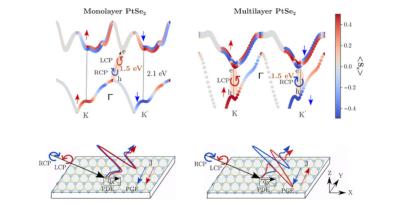Researchers use perovskites and 2D TMDs to create a promising valleytronics material
Researchers from the US DOE Brookhaven National Laboratory, together with Northrop Grumman, have found a way to maintain valley polarization at room temperature using novel materials and techniques.
The researchers used a chiral lead halide perovskite material (R/S-NEAPbI3). The researchers layered 500 nanometer thick flakes onto a monolayer molybdenum disulfide (MoS2), to create what is known as a heterostructure. Using a linearly polarized laser to excite the heterostructure the researchers fabricated and then measured the light that was emitted from the molybdenum disulfide TMD using a confocal microscope. They have discovered that the new material is promising for valletronics applications.
